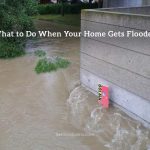Water damage can turn a calm morning into chaos within minutes. Whether it’s a burst pipe or a heavy downpour, knowing what to do immediately can make the difference between minor cleanup and costly repairs. Below, we explore how quick decisions help limit the damage, the simple steps every homeowner should take first, and when professional restoration teams become essential long before the problem spreads beyond control.
Identify the Source and Stop the Flow
Water travels quickly, and the beginning moments after a leak or burst pipe are super critical. Start by locating the water source and turning off the main supply valve. Doing these first things can also help reduce possible insurance problems, according to expert water damage prevention and claim tips.
Once you stop the water flow, concentrate on getting rid of all standing water that keeps getting bigger. Towels, mops, and little pumps can prevent the damage before it turns really serious. However, never step into flooded spaces until you confirm that the power is completely shut off to avoid getting shocked.
Document everything you observe before beginning cleanup. Capture photos and brief videos of the damaged sections, soaked materials, and any leaking devices. These records assist when filing insurance claims and direct professionals later if specialized repair or restoration becomes necessary.
When the source stays unclear or water keeps showing up, it could be trapped within walls of ceiling spaces. In that case, professional water damage restoration Seattle experts can discover hidden leaks with special tools and prevent long-lasting structural damage that often goes unnoticed by regular people.
Dry Out the Area and Prevent Mold Growth
After fixing the leak and removing extra water, the focus needs to shift to drying the room completely. Moisture that remains behind can quickly cause odors, weaken materials, and lead to mold growth that spreads through hidden corners and surfaces if not handled early.
Start by improving air circulation. Open windows and doors to build cross-ventilation, then run fans or dehumidifiers to draw moisture out of carpets and walls. Keep these devices working for many hours, as trapped humidity can stay long after surfaces seem dry.
Check furniture, rugs, and wooden objects that absorb water. Move them outside or to a dry, open area. Avoid direct sunlight on fragile fabrics or wood finishes, and prepare your home for power outages with a generator readiness checklist to hold drying efforts constant.
Once the space appears dry, look for any stale smell or dark marks that may signal the start of mold growth. Wipe surfaces with a mild cleaning solution and water to clear residues, and continue airing the space for another day to ensure all moisture is gone.
When to Call a Professional Water Damage Team
When everything appears dry, some homeowners think the job is finished completely. But water can hide in spots you can’t see like under floors or inside wall spaces. Over time, these wet spots weaken the house. That’s why treating hidden water carefully before it causes big problems is super important.
Professional teams that handle water damage use tools that sense hidden moisture. They use heat cameras and strong dryers to make sure nothing stays wet. Their goal is to keep homes strong and safe, and to prevent an increase in water damage claims.
If the problem is big, touches power lines, or includes dirty water, you should always call trained workers. They clean carefully and follow health rules to remove bacteria and mold. This helps stop health problems that often appear after flooding or leaks.
Over to You
Handling water damage properly means finding and stopping leaks fast, removing moisture you can’t see, and ensuring the home’s structure, air quality, and safety return to how they were. Getting professional help early and designing a forever home that’s protected against problems can safeguard your family’s health and comfort for years to come.






